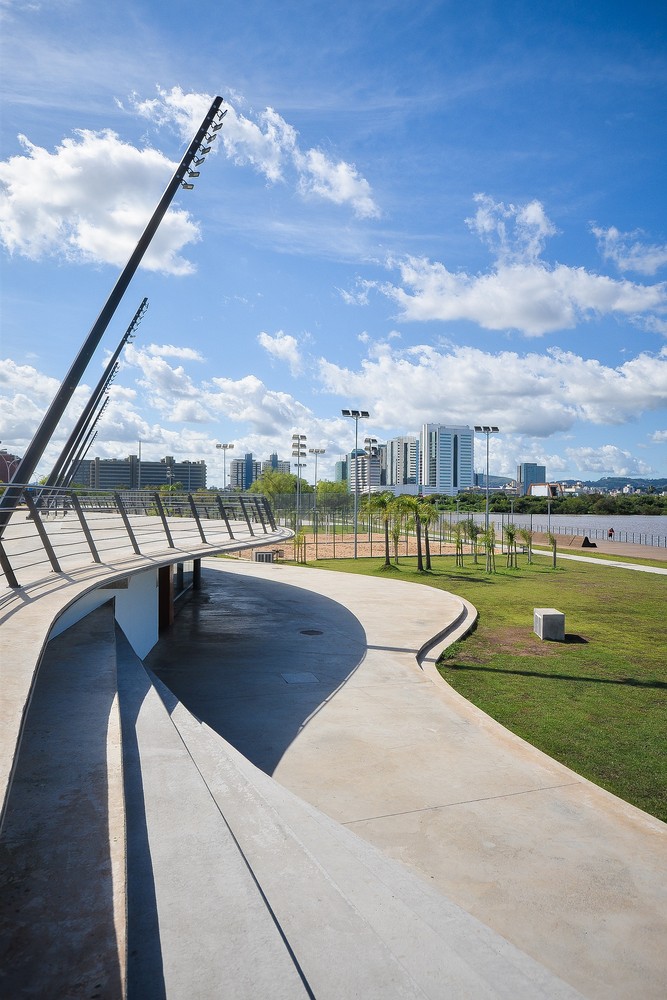Torre de Palma Wine Hotel João Mendes Ribeiro
2014-11-18 01:00
© do mal o menos - Eduardo Nascimento e João Fôja
(C)Do mal o menos-Eduardo Nascimento e Jo o F ja


架构师提供的文本描述。在Alentejo地区大低地的景观中,Torre de Palma庄园包括一定程度的农田和一大群限制在地产东南侧的建筑物。在这一特殊环境中安装一座葡萄酒酒店的项目,旨在响应新的功能规划,同时尊重已建骨料及其周围景观的建筑和形态特征。干预措施包括修复和改造旧农场建筑,以及从零开始建造一套新的建筑,以精确的姿态为基础,尊重土地的独特特征。
Text description provided by the architects. In the landscape of the great lowlands of the Alentejo region, the Torre de Palma estate includes an extent of agricultural fields and a sizable group of buildings confined on the southeast side of the property. The project for the installation of a Wine Hotel in this particular environment aimed to respond to the new functional program while respecting the architectural and morphological features of the built aggregate and its surrounding landscape. The intervention included both the repair and remodeling of the old farm buildings and the construction from scratch of a new set of buildings, based on precise gestures, respecting the lands' exceptional features.
Floor Plan


在重建预先存在的结构时,每座建筑的总体结构都保持不变,只包括内部空间的几处微小变化,以及在需要时插入新的开口。在必要的情况下,结构元件、屋顶或涂层也被更换。
In the reconstruction of the pre-existent structures, the general configuration of each building was kept, comprising only a few minor changes in the interior spaces and the insertion of new openings when needed. Wherever necessary, structural elements, roofs or coatings were also replaced.
© do mal o menos - Eduardo Nascimento e João Fôja
(C)Do mal o menos-Eduardo Nascimento e Jo o F ja


这些新建筑有两种不同的性质:一种是完全新的建筑,被置于原已建成的集料之外;另一种是新的建筑物,它们取代了旧建筑-退化了,没有历史或建筑兴趣-具有新的共同的材料特性:混凝土结构、砖墙和混凝土板屋顶。
The new constructions had two different natures: entirely new buildings that were placed outside of the original built aggregate and new buildings that replaced old constructions – degraded and with no historic or architectonic interest – with a new common material identity: concrete structure, masonry walls and concrete slabs roofs.
© do mal o menos - Eduardo Nascimento e João Fôja
(C)Do mal o menos-Eduardo Nascimento e Jo o F ja


一般来说,土地保持其原有的特征,并根据每个地区的具体情况,微妙的变化。为了统一空间,主院子是用稳定的粘土铺成的,周围是传统的白色大理石鹅卵石,来自阿伦乔地区。在主集合之外,建立了五个不同的区域:靠近古老的“Levada”(传统灌溉渠道)的葡萄园;靠近新游泳池的橄榄园;有种植有机蔬菜和草药的大型花园床的厨房花园;靠近农场仓库的果园和靠近马厩和骑马竞技场的草甸区。
In general, the land kept its original features with subtle variations according to the specificity of each area of the estate. In order to unify the space, the main yard was paved with stabilized clay, bounded by a perimeter in traditional white marble cobblestone from the Alentejo region. Outside the main aggregate, five different areas were created: a vineyard close to the ancient “levada” (a traditional irrigation channel); an olive grove close to the new swimming pool; a kitchen garden with large garden beds for organic vegetables and herbs; an orchard area close to the farm warehouses and a meadow area close to the stables and the horse riding arena.
© do mal o menos - Eduardo Nascimento e João Fôja
(C)Do mal o menos-Eduardo Nascimento e Jo o F ja
























































Architects João Mendes Ribeiro
Location 7450 Monforte, Portugal
Category Renovation
Design Team Luísa Bebiano (in the Wine Cellar and Cottar House buildings)
Project Year 2014
Photographs do mal o menos - Eduardo Nascimento e João Fôja
























